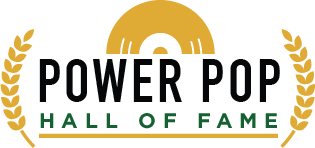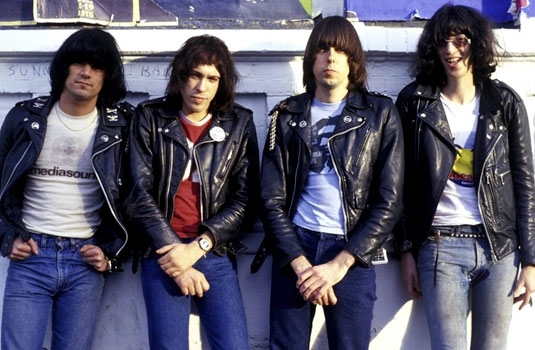The Ramones
The Ramones were one of the great power pop groups. They were also one of the great punk groups (of course), and one of the great bubblegum groups, and one of the great all-out rock ‘n’ roll groups. If these seem to be contradictory claims, I betcha Walt Whitman would have understood. The Ramones were large. The Ramones contained multitudes.
But the “power pop” part of that picture is dismissed far too often. Visually, The Ramones didn’t match any recognized notion of how a power pop band should look; they bore not even a superficial resemblance to The Raspberries, Cheap Trick, or The Knack, nor to power pop progenitors like The Beatles, The Kinks, and The Who. Their sound was rougher, less overtly melodic, lacking in harmonies, nearly bereft of jangle, lyrically more concerned with sniffing glue and beating on the brat with a baseball bat than with going all the way, wanting you to want them, or what the little girls do. Sharona is not a punk rocker. The Ramones were dirty–not leering-dirty like the salaciously horny approach of much power pop, but grungy, filthy punks. This is pop?
Well…yeah. Yeah, it’s pop. And it’s power pop.
Like much of the other power pop music we love, the music of The Ramones was rooted in the British Invasion, in hit singles played loud ‘n’ proud on transistor radios across the USA in the mid ’60s, in The Beatles and The Who and The Kinks and Herman’s Hermits. The Ramones added The Stooges, The MC5, and The New York Dolls to their blend of influences, but retained the 16 magazine appeal of fave raves and high-energy pop 45s. For their first single, they didn’t imitate Lou Reed or Bowie or Iggy; they tried to copy The Bay City Rollers, translating the “S! A! T-U-R! D-A-Y! Night!” of the Rollers’ first U.S. hit into the “Hey-Ho, Let’s Go!” chant of “Blitzkrieg Bop.” This was not coincidence; this was design and intent. The Ramones thought they were a bubblegum band. With their volume and ferocity, their bubblegum became power pop almost incidentally…but gloriously.
Listen to The Ramones’ early singles. “Blitzkrieg Bop.” “Swallow My Pride.” A cover of The Rivieras’ “California Sun.” “Sheena Is A Punk Rocker.” “Rockaway Beach.” The perennial classic oldie “Do You Wanna Dance” (with its incredible B-side “Babysitter”). The supposedly country (but not hardly) “Don’t Come Close.” A cover of The Searchers’ “Needles And Pins.” If these aren’t power pop, then power pop does not exist. This is the sound of an AM radio exuding sheer cool, radiating with both pimply hyperbole and rock ‘n’ roll swagger, its fist in the air, its heart on its sleeve, its volume set to MORE!! The kids are losing their minds. It may not seem so at first glance, but the kids are all right.
On This Is Rock ‘n’ Roll Radio (a power pop radio show named after a line in a Ramones song), we routinely refer to The Ramones as “The American Beatles.” This is certainly not a comparison of units shipped and sold–if The Ramones ever released a counterpart to The Beatles’ compilation 1, they’d have to use a negative number–but it’s an acknowledgement of the comparably fab impact that Johnny, Joey, Dee Dee, and Tommy (and Marky, and Richie, and C.J.) had on my life as a rockin’ pop fan. Hearing The Ramones when I was 17 was nearly as important as seeing A Hard Day’s Night when I was four. It was the sound of freedom, liberation, possibility…and it was catchy! When Bomp! magazine published its power pop manifesto issue in 1978, writers Greg Shaw and Gary Sperrazza! were savvy enough to realize that the power pop story stretched from the British Invasion through The Raspberries, Big Star, The Flamin’ Groovies, and The Dwight Twilley Band, and that it for damned sure included The Ramones. Even into the ’90s, when I talked with Shaw about power pop, he made a specific point of citing “Rockaway Beach” as one of power pop’s defining singles. And he was right.
Like The Beatles, The Who, The Kinks, and Cheap Trick, The Ramones built a musical legacy that encompasses power pop but is not exclusive to it. It’s easy to look at the leather jackets and leathery sneers, to read the twisted lyrics of “Glad To See You Go” or “Gimme Gimme Shock Treatment,” or experience the breakneck 1-2-3-4! pace of a Ramones concert and conclude that a belief in The Ramones as a power pop band is just the fevered result of huffin’ too much Carbona. But the evidence is there. It’s in the grooves, where it should be: playing back at 45 or 33 1/3, on tape or compact disc or digital download, AM or FM, in your head, under your skin, and in that forever-young heart you’ll listen to next time. The melody! My God, there is indeed melody–irresistible, undeniable melody–that no amount of bludgeoning can obscure. Melody that’s faster. Louder. Immediate. Unforgettable. Melody with a sense of menace, a feeling that everything could careen out of control at any second, yet all in its perfect place within the familiar parameters of a 7″ slab of vinyl. It’s still a thrill. It’s still worth swooning over. It’s still worth turning up. And it’s still power pop to me.
Take it, Dee Dee! (Source: Carl Cafarelli)





